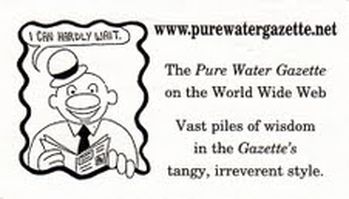Special Mid-Month Issue February 15, 2013 |
|---|
We hope you'll read the Pure Water Gazette's "Today's Top Water News" section. New articles appear daily. Some examples of recent posts are included in his issue. |
In the News
The Big Brackish Water Desalination Plant for San Antonio is Now Underway
Beginning as a project recommended in the 2007 Texas State Water Plan, an ambitious brackish water desalination project for the San Antonio area is now underway.
Brackish water is water that is too high in mineral salts for human use. The project will take underground brackish water and make it usable by reverse osmosis.
Using $109.5 million in Texas Water Development Board funds from the Water Infrastructure Fund, the project, called SAWS, is building a wellfield, reverse osmosis water treatment facility, concentrate (waste water) management facilities and integration pipeline. Desalination–the process of removing dissolved salts from water so that it can be used as fresh water–will add greatly needed water to the San Antonio area.
Texas is in the process of a major expansion of its water resources. San Antonio's SAWS project is an important step in the right direction.
 |
|---|
Texas Big Shots Acting Like Fools in a Staged Photo to Kick Off San Antonio Brackish Water Project |
Chemical Feed Pumps: What They Do and How to Use Them
Chemical/Mineral feed systems are among the most effective, versatile, and cost-efficient of water treatment devices.
Depending on the chemical agent used, the same equipment can treat bacteria, iron, manganese, low or high pH, hydrogen sulfide (rotten egg smell), and many other water problems.
What is more, multiple problems can sometimes be addressed with a single treatment. For example, if the pH of your water is too low for effective iron removal, you can increase the pH by injecting soda ash and add chlorine to oxidize the iron in a single operation. And equipment purchased for one purpose can be easily converted to another.
Chemical feed pumps work by injecting the selected chemical under pressure into the water stream. Such pumps are used almost exclusively to treat well water, and the most common point of injection is between the well and the well's pressure tank.
Here's a diagram of a standard feed pump setup:
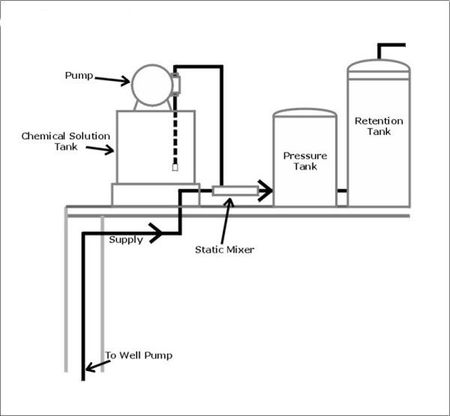 |
|---|
| Chemical Feed System--Classic Setup. Most Residential Injection Systems Are Built on This Pattern. |
The Chemical Solution Tank contains the chemical to be injected. The pump draws the liquid solution via the pick-up tube (dotted line in the diagram) and injects it under pressure into the water line on its way to the well's pressure tank. The static mixer in the picture is an optional part that enhances rapid mixture of the chemical with the water (see How Static Mixers Work); it can be replaced with a simple tee connection. The water with the chemical injected proceeds to the pressure tank and then to a retention tank which is included to give the chemical sufficient residence time in the water. Solution tanks must often be quite large since some chemicals, chlorine for example, need as much as 30 minutes in the water to do their work.
Determining Dosage
The actual dosage of the chemical is determined by considering and adjusting a number of variables which include the flow rate of the water at the point of injection, the feed rate of the injection pump, and the strength of the solution.
One reason for injecting the solution before the pressure tank is that this is the only place in the home's entire water system where the rate of flow is consistent. Although some injection pumps pump only at a single, pre-fixed rate and some very sophisticated systems are able to automatically adjust their injection rate to match the flow rate of the water, most pumps have variable speed settings that allow adjustment within the pump's output capabilities. For example, a pump may be capable of injecting at the rate of 3 to 10 gallons per day and it will have a 1 to 10 speed control, so that setting at the mid range might give a flow rate of 7 gallons per day.
The solution strength, the final variable, gives the operator great control over the final dosage. For example, If straight household bleach is put into the solution tank, the solution strength will be 52,500 parts per million chlorine. If a gallon of bleach is diluted with a gallon of water, the strength of the solution being fed becomes 26,250 ppm. This simple system of dilution can be used with most chemicals although some, like hydrogen peroxide, must be diluted only with very pure water.
Although determining dosage can be complex, fortunately there are charts and calculators that make it fairly simple.
Pump Types
Feed pumps are usually electric and are of the common diaphragm style or the popular "peristaltic" positive displacement design. There are also non-electric pumps that are powered by the flow of water through the pipe.
 |
|---|
The peristaltic pump mimics a principle called peristalsis that is used in many biological systems, such as the gastrointestinal tract. In simpler terms,the peristaltic pump works by squeezing a flexible tube that is filled with liquid so that the liquid squirts out of the open end of the tube. |
Common Uses of Feed Pumps
Here are some examples:
Inject chlorine to control bacteria.
Inject soda ash or caustic soda to raise the pH of acidic water.
Inject hydrogen peroxide to treat hydrogen sulfide (rotten egg odor).
Inject citric acid or vinegar to lower the pH of alkaline water.
Inject chlorine to oxidize iron to facilitate filtration.
Inject hydrogen peroxide to prepare iron for filtration.
Inject polyphosphates to "sequester" iron or hardness to prevent staining and scale formation.
 |
|---|
| A different design. This non-electric injection pump is powered by the flow of water through the pipe and its injection speed varies according to the rate of water flow. It can, therefore, be installed anywhere in the water line. |
Does the Fluoride Reduction Medium Activated Alumina Add Aluminum to the Water It Treats?
One of the persistent legends that flies around the internet involves the belief that activated alumina, a manufactured water treatment product, gives up aluminum and adds it to the water being treated. Although we've never seen evidence that this happens, we were happy to find that someone has researched the issue. The prestigious European Food Safety Authority in 2006 investigated the rumors about the safety of activated alumina and published its findings. We've reprinted the findings on the Pure Water Gazette's website, but you can find a more readable PDF version here. If you don't want to read the entire document here's the answer to the title question: no. –Hardy Waite, Editor, Pure Water Gazette.
In many water systems, as much as 20% of the treated water is lost to leaks
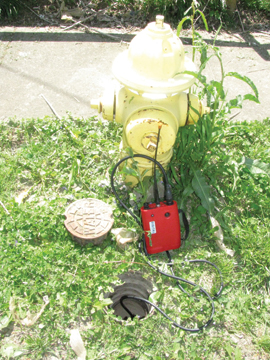 |
|---|
An Acoustic Leak Monitoring Device A frequently overlooked factor in water conservation is the important matter of detecting and fixing leaks. Leaks are more common and more significant than most of us believe. Leaks are a significant contributor to water shortages. Please read Dan Rafter's important study of leaks in municipal water systems which we've reprinted on the Gazette's website. The original publication is from Water Efficiency magazine. |
Photos Taken at Don Juan Pond Reveal Secrets about the Pond and Possibly Water on Mars As Well
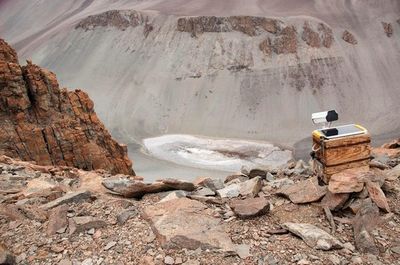 |
|---|
Antarctica’s strange Don Juan Pond is the saltiest natural body of water on Earth, a condition that keeps the little pond from freezing in an otherwise frozen continent.
|
There has been speculation but no real understanding of how the pond gets enough salt to avoid freezing and also how it gets its water.
A Brown University researcher took more than 15,000 pictures over a period of two months in attempt to answer these questions (see photo above). Evidence gathered from the pictures may also give clues to how liquid water might also flow on Mars.
The photos revealed that the pond’s water level rises slight with the temperature (indicating that there might be a bit of melting snow that adds to the pond’s water) and also dark streaks that could indicate that calcium chloride is being washed into the pond by the tiny water flow from melted snow.
Please read more details of the Don Juan Pond photo studies and their significance at the Science at NBC News website.
Lolong, The World’s Largest Saltwater Crocodile in Captivity, Dies in the Philippines
 |
|---|
In its September 2011 issue, the Pure Water Occasional reported the spectacular capture of Lolong, the world’s largest saltwater crocodile in captivity, near a small southern town in the Philippines. In February 2013 we must report Lolong's demise. Click picture for larger image. |
Although the giant crocodile was hunted and captured as a safety measure after he had been blamed for the deaths of several villagers, after his capture he become a local celebrity and a formidable tourist attraction that brought fame and dollars to the town of Bunawan.
Bunawan plans to preserve the remains of the 1-ton crocodile in a museum to keep tourists coming and stop the community from slipping back into obscurity,
Lolong was declared dead after he was found floating on his back with a bloated stomach in a pond in an ecotourism park which had begun to draw tourists. The fame of the immense reptile was spreading rapidly, and the town was planning a new road to accommodate tourists.
The cause of death is unknown, and an autopsy will be performed by wildlife experts.
Lolong was estimated to be over 50 years old. He measured 20 feet 3 inches in length and was proclaimed the world’s largest saltwater crocodile in captivity by Guinness World Records.
According to Yahoo News:
Even though Lolong was blamed for the deaths of several villagers over the years, Bunawan villagers grew to love the giant reptile because it came to symbolize the rich biodiversity of the marsh where it was captured. The vast complex of swamp forests, shallow lakes, lily-covered ponds and wetlands is home to many animals, including threatened species such as the Philippine hawk eagle.
Various religious groups offered prayers Monday and spiritual leaders also planned to perform a tribal funeral rite, which involves butchering chickens and pigs to thank forest spirits for the fame and other blessings the crocodile has brought, Bunawan mayor Elordie said.
The rite is to be held at the ecotourism park, where the reptile was a star attraction, drawing foreign tourists, scientists and wildlife journalists to Bunawan, a town of 37,000 people about 515 miles (830 kilometers) southeast of Manila.
Worst water news story of the month: An Ohio school cancelled its prom as punishment to students who participated in a water balloon fight.
The Garden Hose Filter: A Versatile and Very Useful Tool
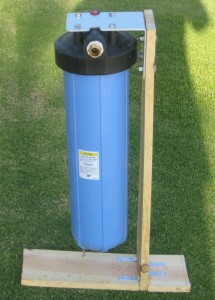 |
|---|
The garden hose filter above, mounted on a stand designed by its owner, is used to soften water used for rinsing roof-mounted solar panels. Softening the water prevents streaking and scale build-up on the panels and allows the user to avoid the dangerous and difficult task of climbing onto the roof to hand-clean the panels.
This is only one of many uses of the very versatile garden hose filter. Other common uses are providing clean, good-tasting drinking water for work crews via a garden hose, removing chlorine or chloramine from water used to irrigate organic gardens, providing chemical-free water for fish ponds and aquariums, removing sediment that can stop up irrigation emitters, providing soft water for washing cars, boats, motorcycles, patios, driveways, and, as stated, roof-mounted solar panels.
Cartridge-style garden hose filters come in many sizes. The filter above uses the largest–the 4.5″ X 20″ cartridge. Other popular sizes accommodate 2.5″ X 9.75″, 2.5″ x 20″, and 4.5″ X 9.75″ cartridges. They can be wall mounted, mounted on a custom-made stand, like the filter above, or simply tossed on the ground. They are durable: dirt and water don’t hurt them.
Garden hose season is just getting into full swing. Demand for garden hose filters is strong from early spring right up to National Garden Hose Day, which is celebrated in the hottest part of summer.
Go here for everything you ever wanted to know about garden hose filters.
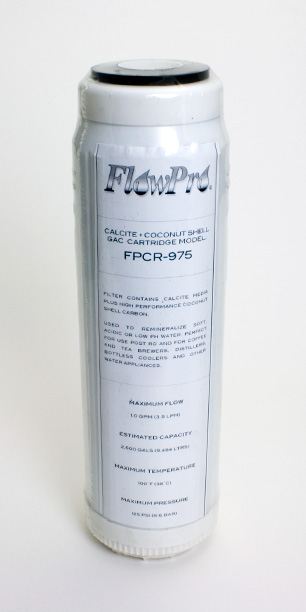 |
|---|
Above is an "axial" style media cartridge. It contains calcite, a sacrificial medium that raises pH and adds minerals to low pH water, plus coconut shell carbon for taste/odor and chemical treatment. Its most common application is as a reverse osmosis postfilter. More information. Go here on our main website for a complete listing of filter cartridges in this size. |
Early February Water News
The Pure Water Gazette features a top water news story each day. Here's what you missed in the first half of February if you haven't been reading the Gazette:
The new Gazette format also indexes much of the significant content of the old online and paper versions of the Pure Water Gazette. Take some time to browse. As our ad says, you'll find "Vast piles of information in the Gazette's tangy, irreverent style."
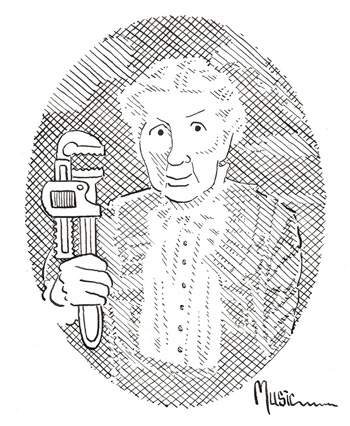 |
Water Treatment 101: Why UV Is Gaining in Popularity for Microbe Control in Well Waterby Pure Water Annie Technical Wizard Pure Water Annie Describes How UV Fixes Unsafe Water |
|---|
By its nature, water provides a an inviting growing place for bacteria. Bacteria, viruses, and protozoa are small creatures, but when ingested over time and in sufficient quantities they can lead to serious health problems. E coli, a member of the coliform family of bacteria, has received enough public attention to be feared and respected, although it is only one of many microorganisms that can be dangerous.
Actually, bacteria are fairly easy to control as compared with cysts like giardia and cryptosporidium, which are bigger, tougher and very difficult to kill with conventional water treatment disinfection chemicals like chlorine. Cysts have a protective outer shell that shields them from municipal water treatment chemicals.
Essentially, there are three strategies that can be used to control potential disease-causing microbes in water.
1. Chemical treatment with chlorine, chloramine, hydrogen peroxide and other less frequently used disinfectants. Chemicals are not effective against cysts. Chemicals remain the treatment of choice for municipal water supplies, however, because chemicals like chlorine provide a residual effect that stays in the water all the way to the home.
2. Straining through very tight filters. Bacteria, for example, can be removed by very tight sub-micron filters, and cysts, which are much larger, are easily blocked out even by a one or two micron filter. Straining is a popular strategy for emergency filters and small point-of-use drinking water filters. It can be applied for cysts in larger applications, though flow restriction usually makes it impractical for bacteria control where significant flow rates are required.
3. Ultraviolet treatment which eliminates both bacteria and cysts. Ultraviolet treatment (UV) involves passing the infected water by an ultraviolet lamp that has enough intensity to alter the DNA of water-borne pests. UV is becoming the favorite technique for well owners because it is easy to install, easy to maintain, and relatively inexpensive. It is also popular because it provides a complete treatment and adds nothing objectionable to the water.
More About UV
Disinfection chemicals like chlorine are measured in “parts per million” of the disinfectant. Straining devices are measured by the micron size of the filter. UV is a little more complicated. The standard measure of UV dosage is mJ/cm2, or megajoules per square centimeter. This number is a measurement of the intensity of the lamp with consideration of how fast the water flows past the lamp. Although the NSF Class A standard is 40mJ/cm2, in the water treatment industry it is generally assumed that 30mJ/cm2 is more than enough to treat residential well water. In fact, a 16mJ/cm2 unit is twice as hot as it needs to be for common well water contaminants. 6-10mJ/cm2 is sufficient for most pathogens. 6mJ/cm2 will do away with 99.99 percent of E. coli.
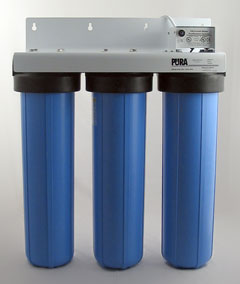 |
|---|
| The full-size Pura UVB3 whole house treatment unit has sediment filter, carbon block filter, and UV lamp built into a single unit. Our website purauv.com features all models and all parts for plastic Pura UV units. |
Gazette Numerical Wizard Bee Sharper Reviews Important Numbers You May Have Missed Last Year |
 |
|---|
Sharper's Index 2012 Review
by B. Sharper
Editor’s Note: These are all current events items. And, in case you haven't noticed:
Number of B's Ms. Sharper used to have in her name: 2
Number of B's Ms. Sharper now has in her name: 1.
– Hardly Waite.
Number of big shots who showed up to have their picture taken at the recent SAWS dedication in San Antonio -- 9.
Parts per million chlorine in common household bleach -- 52,500.
Percentage of treated water lost to leaks in many water systems--20%.
Number of pictures of Don Juan Pond taken over a two month period by Brown University researchers -->15,000.
Age of Lolong, the mighty crocodile, at time of death -->50 years.
Approximate weight (estimated, since he refused to get on the scales) -- >1 ton.
Lolong's length-- 20 feet, 3 inches.
Rank of Lolong among saltwater crocodiles in captivity, according to Guinness - #1.
Date of National Garden Hose Day -- Aug. 3.
Megajoules per square centimeter rating required for Class A NSF UV rating-- 40.
Filter size needed to block out cysts like Giardia and Cryptosporidium -- 1 or 2 micron.
EPA's current recommended fluoride level for warm weather areas -- 0.7 ppm.
EPA's current recommended fluoride level for cold weather areas -- 1.2 ppm.
Fraction of the Yellow River's total water content that is currently being consumed by coal and chemical companies -- 1/4.
Thanks for reading and
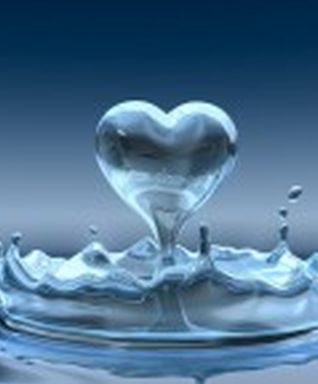 |
|---|
Happy Valentine's Day |
Here are some sections on the Occasional's website that you will want to visit:
Links to Pages about Water and Water Treatment
New Products from Pure Water Products
Pure Water Annie's Glossary of Water Treatment Terms
The Pure Water Occasional is a project of Pure Water Products. Please visit our websites: Main Website: www.purewaterproducts.com This site features our full range of products, plus instructions, technical articles, product manuals, and more. The Occasional's Website: www.purewateroccasional.net. In addition to archiving back issues of the email Occasional, this site houses a sizeable section about water contaminants, a "how things work," series, a new products section, a glossary of water treatment terms, and, "much, much more." Other Pure Water Products Sites: www.purauv.com To contact us by phone, please call 940 382 3814.
|
|---|

